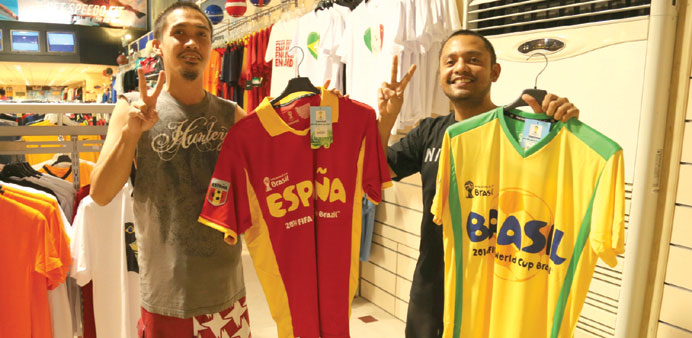By Ramesh Mathew/Staff Reporter
|
With the ‘greatest show on Earth’ set for a grand kickoff in Brazil tomorrow, football-crazy fans in Qatar are turning up at sports goods retailers in large numbers to grab the jerseys of their favourite team. |
Most sellers of sports accessories in Qatar are reporting a high demand for jerseys of the teams participating in the 2014 FIFA World Cup, especially the favourites, as well as related accessories and sports gear.
While the demand for jerseys and accessories in the national colours of Argentina and Brazil is the highest, other countries, too, are highly popular among local football enthusiasts.
A child tries his footballing skills near
racks of World Cup apparel.
“There is no doubt that the jerseys of Argentina and Brazil continue to be the leaders (in terms of sales) at local sport shops, but football enthusiasts also show a lot of interest in the colours of Germany, Spain and England,” said an apparel manager at Safari Hypermarket, with Italy and France next in terms of popularity.
“At some of the shops frequented by affluent locals, the national colours of these two teams, particularly Italy, have a strong presence,” said a retailer.
While the inexpensive apparel and merchandise of the top teams are sold between QR40 and QR60, the more upmarket shops stock mostly high-quality jerseys, which start from QR250.
There are some customers who buy jerseys of more than two or three participating teams.
The buyers of football apparel at mid-level standalone shops are mostly youngsters from countries such as Egypt, Lebanon, Syria, Morocco, Algeria and Jordan. At most of the big, branded sports goods shops, the customers are mainly locals and western expatriates, according to retailers.
The boom in the sale of jerseys and other World Cup-related accessories in the Qatar and other regional markets has become more discernible since the 2002 edition jointly hosted by Japan and South Korea (the first to be held in Asia), say industry specialists.
“Though such items have been sold for years, albeit on a lower scale, the business has picked up in a big way from the 2002 World Cup onwards,” said Ali Montasir, who has been working in the sports accessories sector for years.
Industry insiders like him also attribute the boom to the large-scale arrival of Chinese-manufactured goods in the market.
“The sale of sportswear during the World Cup began to shoot up across the region only after major international brands outsourced their production to Chinese companies,” said another retailer. “Sports kits in national colours, particularly jerseys, used to be a little expensive in the local market until the beginning of the millennium. However, their production in China has made such accessories cheaper and even those customers who could not afford the big brands earlier have now started buying them.”
Elaborating on how prices have come down, a retailer said while jerseys of decent brands used to cost between QR150 and QR180 each some 20 years ago, one can now buy three or four of these in the local market for the same price.



